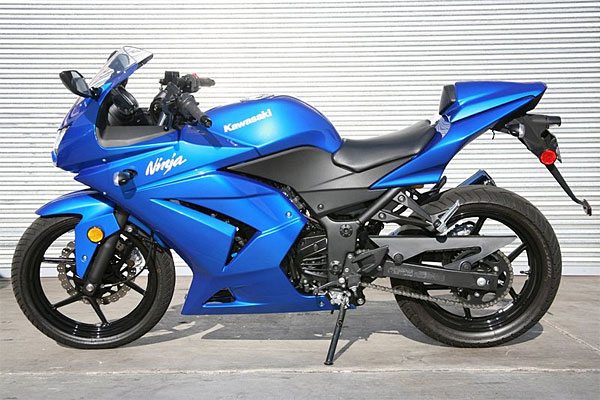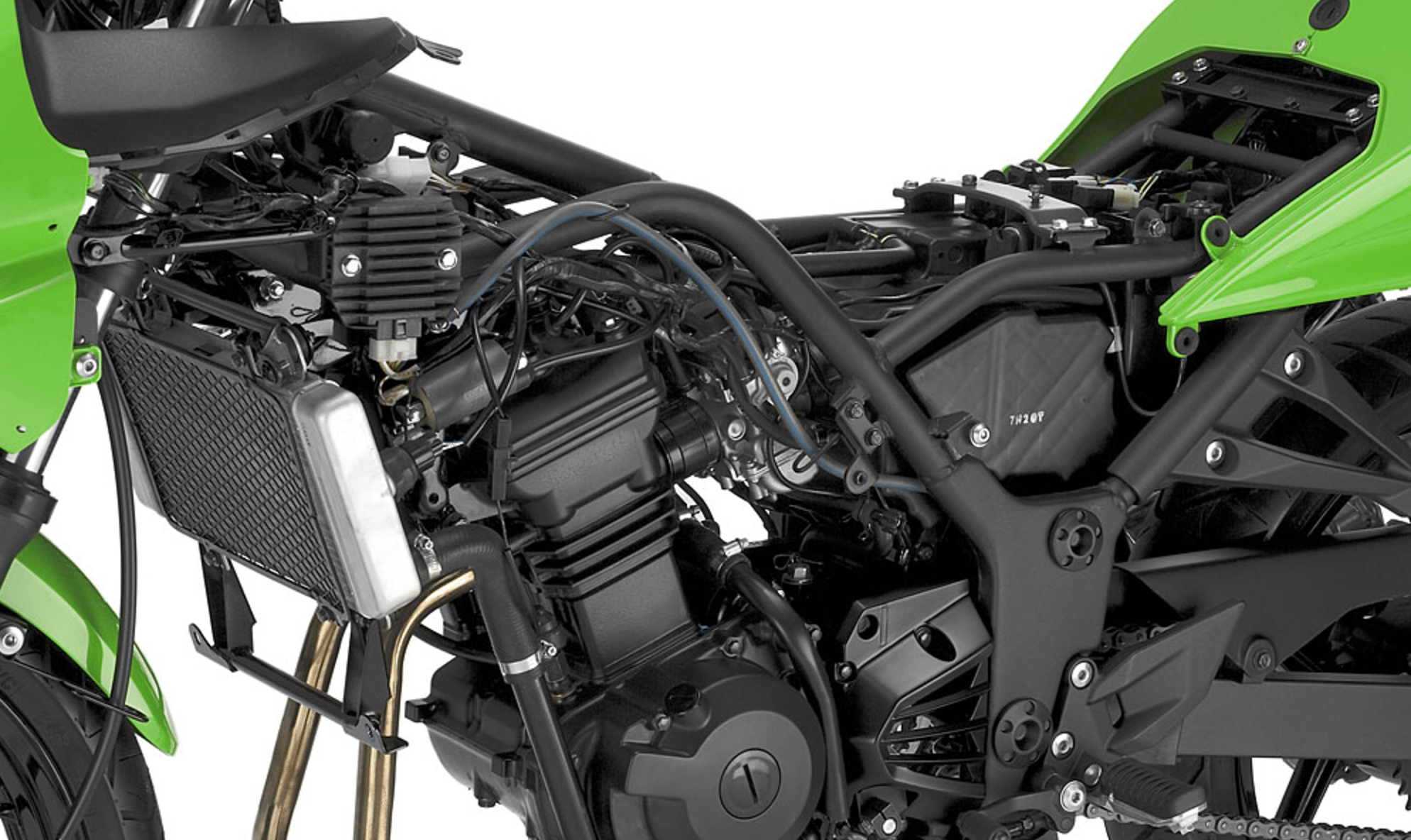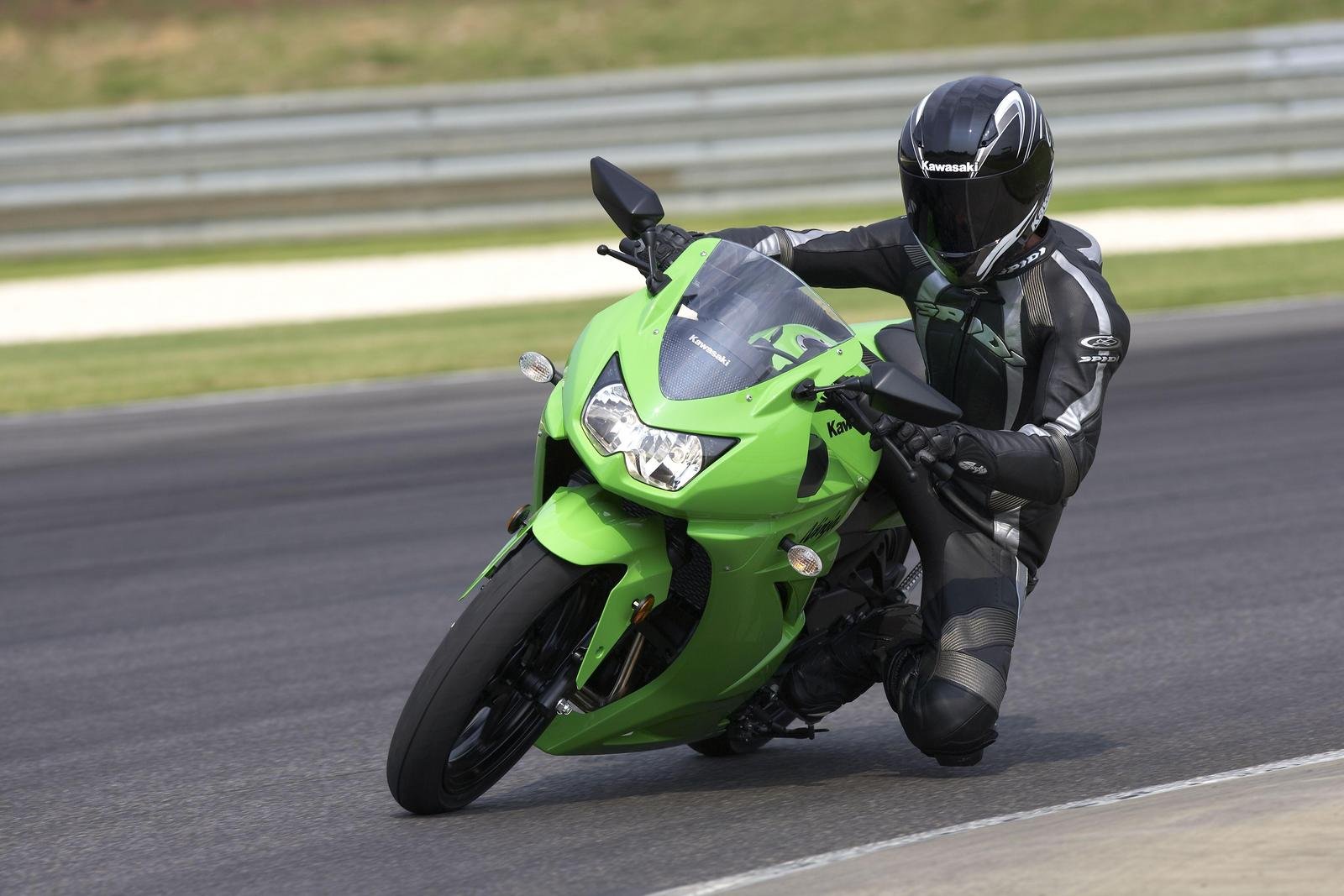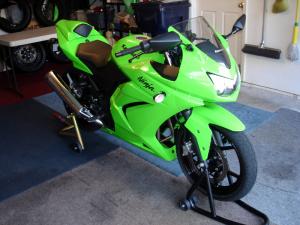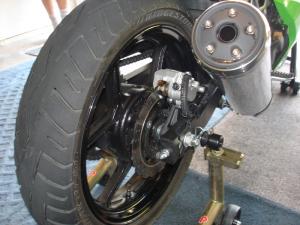2008 Kawasaki Ninja 250 Review
Best Beginner Motorcycles was lucky enough to catch up with Gary Jaehne, the author of Sportbiking – The Real World: The Advanced Riders Handbook and Sportbiking – The Real World 2: Rider and Bike Tuning Handbook. Gary Recently purchased one of the ’08 Ninja 250s and has written a 4 part ride report of his experience.
Ninja 250 – First 50 Mile Ride; “Real World” Impressions
Just got home from logging the first 50 miles on one of the new 3rd-Generation (’08) Ninja 250s (that I just took ownership of thanks to a surprise from an incredibly cool Wife!), and decided to try to do a quick brain-dump of my first impressions of the bike. First impressions are generally some of the most valuable moments in getting unbiased and accurate feedback.
The combination of having not yet seen any full-blown road tests of the ’08 Ninja 250 show up in print within any of the mainstream motorcycle publications, not seeing anyone locally post a real world impression of one yet on the forum, and the recognition that few (if any) of the eventual magazine testers will have roots as deep into these little bikes as myself (83K miles, and roadracing)…… I decided to put those thoughts down here for anyone that has an interest in this bike. Read on, or skip ahead to the next thread, as fits for you.
In an effort to provide an effective method for readers be able to skim through the write-up to the key elements that interest them about the bike, I decided to break things down by key elements, and then expound on each with impressions from this real world first ride.
All of the evaluations will be based on a premise of “comparison”, with the reference point being the previous generation (1988-2007) Ninja 250.
What item(s) most positively impressed?
1) The engine – torque/midrange 2) The “firmness” (no bottoming out) of the suspension 3) The precision and smoothness of the transmission’s shifting
What item(s) were less than perfect?
1) The “firmness” of the suspension (less forgiving on bumpy backroads) 2) More wrist weight on the handlebars (extended miles riding comfort)
ENGINE:
The press info that’s showed up from Kawasaki has stressed the changes to the engine being focused on “increased midrange”. Reading this same shtick in multiple places I’d been left with the impression it was just a marketing way of trying to draw attention away from a potential loss of horsepower that the more heavily smogged ’08 engine was going to produce.
From a first ride, first impression perspective, I’ve got to give the engineers a “thumbs-up”, and say …… you guys weren’t blowing smoke! While having to recognize this is only 250cc’s of engine we’re talking about ….. I’ve got to say that this new bike definitely has excellent “grunt” for such a small displacement. There’s no question that this characteristic will be a huge plus to making the bike even more user-friendly for newer riders.
The official recommended “break-in” procedure specifies keeping the engine below 4,000 RPM for the first 500 miles. Say what??? Guess what speed 4,000 RPM is, in 6th gear? 36 MPH!! OK …… sure, I’ll ride the bike for the first 500 miles never going faster then 36 MPH at any time, and that’ll be just fine on the normal public roads …… right!
Today’s first 50 mile ride on the bike was done in a nice loop on some of the less traveled twisty backroads in the Santa Cruz mountains, here in Northern California. Despite the total impracticality of the 4K break-in engine speed, I did consciously keep from revving the engine any higher then was realistically necessary. Keeping the engine lower in RPM then my normal Ninja 250 riding adventures, gave me a perfect opportunity to sample this “mid-range” that the Kawasaki engineers were claiming.
Today’s route included climbing some steep and twisty uphills too. The ability to maintain a steady pull, despite the engine working in a much lower then normal (for spirited riding on one of these little bikes) RPM range, was quite impressive! It almost felt like I had an extra hundred CC’sof engine doing the work. Cool stuff. I can’t comment on the overall power output of the bike at this point, having not yet taken the engine anywhere close to the RPM range (10-13K) where that happens on these little 250cc machines. Once the engine has reached the broken-in phase, I’ll post a follow-up with impressions on that aspect. Stay tuned.
SUSPENSION:
The first perk is that the bike now comes with a 5-position spring “preload” adjuster for the rear shock. That’ll be great for allowing riders to optimize the geometry of the bike for their weight. At 170 lbs, I found position #3 (1 is stock) to be a good starting point. 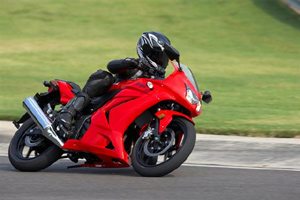
The ’08 bike is downright “firm” in the spring category; front and rear. The stock rebound damping is actually quite controlled too. The front forks rebound is pretty much right on the money (for an old-school technology damping rod design), with the rear shock having a bit too much rebound …… if anything. On today’s brief first-ride, I included a route that covered some of the very tight and bumpy backroads that we make part of our regular weekend rides. The added “firmness” of the new bike’s suspension made things feel a lot more like being mounted atop any of the current crop of hardcore sportbikes, then the rather “plush” feeling of the past generation Ninja 250’s soft suspenders.
A bit of a double-edged sword in this case, as what will make the bike better for pushing a bit harder under ideal road/track conditions (smooth, faster, and minimal bumps), becomes a bit of a handicap in keeping rubber to pavement on some of the rougher roads that exist in the real world. During the last stint of today’s ride I did the run down Felton Empire Road. A good portion of this road is paved with a relatively fresh layer of exceptionally well groomed asphalt, with very few bumps. It was on this section that I first got to appreciate where the new bike’s suspension will shine!The bike is definitely in its element on such pavement conditions, and will likely be able to be ridden quite quickly through the turns when the pavement conditions are right (as in this form of asphalt at a track).
HANDLING:
Conditions during today’s brief ride were not ideal, with the roadways still having a lot of damp spots from recent rains. The road conditions, combined with virgin rubber on the tires, engine break-in limitations, and “new bike syndrome”, kept from getting a full feel for the bike’s handling. Despite that, some general feedback on how the bike responded going into turns, reacted mid-corner, and delivered in making line adjustments was noted from the ride. The new bike seems to have better trail numbers then the previous generation being quite stable for such a small/light bike.
I tried to deliberately induce some headshake on a few straights, to see how the bike would react. Was pleased to see that the bike exhibited a solid degree of self-centering of the steering; actively working to steady things back down very quickly after the deliberately induced wiggle. Despite the stability, the bike definitely was not slow steering. The combination of the bike’s light weight and very narrow tires resulted in the little Ninja turning in with very little effort, and dropping right onto the requested line.
RIDER POSITION:
The feel of being on the two version Ninjas, and riding down the road, are quite different. I’d describe the feeling on the two bikes as: Previous generation:……………….. Sitting “Down in the bike” (low CG) ’08 version:………………………….. Sitting “On top of the bike” (more sportbike feeling) For low speed maneuvers and general control on rough roads, the low CG and seat height of the early generation bike is superior. The ’08 model follows the lead of the more serious sportbikes of today, putting the rider more inline with the upper plane of the bike, which is a great position for carving up turns at higher speeds on good pavement. Good and bad …… depending on the application.
For shorter riders, the older bike was better in this respect.
The more mainstream sportbike orientation of the bars (lower) on the new bike will likely serve as a plus for serious performance use; but will make extended hours in the saddle a little more fatiguing for the more casual rider or commuter. A bit of a win-lose situation; depending on the rider.
TRANSMISSION:
The shifting on the previous generation Ninja 250 wasn’t bad, but it definitely gave you a solid notice when it was being notched up and down between gears. Granted this bike is very new at this point, but the minimal foot pressure required to make gear changes, combined with a very precise feel when the next gear engaged, put a smile on my face.
CLUTCH:
One of the behaviors I’d gotten used to on the previous generation bike, was the “lurch” that was often experienced when dropping the bike from neutral into 1st gear …. especially when cold. It was an issue where the fiber and metal plates had a habit of wanting to not totally disconnect, despite the clutch being properly adjusted and pulled in fully. I was pleasantly surprised that the new bike clicked into 1st gear without so much as a nudge; despite the bike being barely warmed up in the garage before heading out. Nice improvement!
BRAKES:
Being in the early break-in phase, I’d consciously been easy on the brakes during today’s short ride, to allow the pads/rotors to bed-in. During the last few miles of the ride I did experiment a little bit with firmer lever pressure. The bite of the front brake seemed solid for a single rotor/caliper equipped machine. At this point I’d have to rate them to be at least as good as the earlier generation, if not slightly improved.Being a “semi-wave” rotor design, and possibly a different compound in the pads, it’s not unexpected that they might continue to surpass the previous generation bike’s brakes, once I’m pushing them harder.
The rear brake felt good, and not really anything noticeably different then the old bike. Rear brakes are more of a complementary braking tool, and the one on the new 250 seems more then up to the task. Decent “feel”, which is important for a rear brake to be most effective.
SOUND/EXHAUST:
The catalytic equipped single muffler on the new bike is definitely a bit quieter then the twin-pipe generation machines. At idle this added quiet is most noticeable, with the tone and volume becoming more on par with the earlier bike once the RPM and throttle position increase a bit while riding.
I really like the clean look of the single muffler. Kind of wish it were “black chrome” (instead of “shiny chrome”), as it’d blend in nicer with every other non-main color scheme painted item on the bike (swingarm, frame, forks, subframe, wheels, etc) that’s done up nicely in a mean looking black theme.
WEIGHT/FEEL:
Though the spec sheets indicate around a 30 pound increase in weight for the ’08 model, I suspect a portion of that was some under-rated numbers that the original bike may have been carrying around in the brochures for many years. Either way, the weight of the two version bikes didn’t stand out as being different while riding. If anything, due to the higher placed seating position, it made the bike feel lighter …… due to it wanting to flick over to lean angle with less effort.
TIRES:
The OEM tire are Bridgestones, in a 110 size up front and a 130 on the rear, on 2.75″ wide and 3.50″ wide rims; respectively. Though being rubber from a current crop of tire offerings from Bridgestone, they are the older technology “bias-ply” style (versus the state-of-the-art “radials” seen on the high-end sportbikes today). The combination of the conservative pace on today’s first 50 mile break-in ride, and the road conditions, didn’t provide a real chance to find out how good or bad the stock tires perform.
I will say that I didn’t have a single moment of slippage, and did see that the area of the tread surface that was used had been within about ½” of the edges (front and rear) by the time I got home. I found them to be quite decent skins (for OEM rubber) for most riders use.
INSTRUMENTATION:
In this area it was a bit of a gain/lose situation. The gain was the addition of an analog fuel level gauge (which I like!). The loss is the absence of an actual water temperature gauge, being replaced by an idiot-light. The other noticeable change in the instrument cluster is the tachometer; with the difference being the much smaller size on the ’08 machine. On the earlier generation bike the tachometer and speedometer were equal in size; sitting side-by-side. On the ’08 bike the tachometer is significantly smaller then the speedo,and tucked off to the leftside of the cluster.
I guess the thinking is that for safety, a rider should be most focused on their speed, and hence the larger sized gauge for that purpose (?). As a result of the reduced size of the tachometer, the spacing between 1,000 RPM increments is resultantly much closer together. Being able to quickly glance down and immediately determine the current RPM of the engine is a bit more challenging. Not really a problem, but just a bit of a step backwards from that aspect in user-friendliness of the old bike.
FEATURES:
Again a bit of a win-lose situation. The loss is the presence of a center-stand on the bike. Though it added weight, and was a potential ground clearance limiting item, it did make tire changes and bike washings a less daunting task. One of the additions being the welded-on swingarm spool mounting bosses on the back of the new bike.
The hole size of the bosses is identical to many other mainstream sportbikes (the ones off my ZX-10R fit right on!), which makes getting spools an easy task. The spring preload adjuster on the rear shock was already mentioned in the suspension section, but definitely shouldn’t be missed when referencing nice added “features” to the ’08 bike.
QUALITY:
Before ever taking the bike out for its first mile of riding, I spent a number of hours going over ever nut-n-bolt in ensuring the everything was setup right. I was impressed with the way that everything was cleanly designed an put together. Things are in the right places, and well thought out.
When riding the bike, I was impressed with the very “solid feel” that I got from it. Nothing rattled, shaked, or in any way felt out of sorts, despite navigating some rather bumpy roads today. The front and back of the bike felt very “connected”; with neither end moving from side-to-side independently. I guess it just felt like there was more bike underneath me, then what would be expected of economy priced, entry-level 250cc machine.
APPEARANCE:
Last but not least. Regardless of how good a bike performs in every other category, if looking at it parked …… while walking up to it to go for ride ……. doesn’t “move you”, there’s not much chance of true love ever developing in the relationship. The new ’08 Ninja 250 has that covered in spades for me! Looking at the little “Bright-Green Ninja Machine” sitting up on the rear stand in the garage, under the lights, is a pretty sight to see!
The designers of the bodywork and ergos on the new bike did an awesome job in coming up with this new package. The clean look of the bodywork and paint, thanks to a near total lack of the radical poser graphics that have showed up on some machines over the years, is all business. I swear that from a pure “looks” perspective, in my opinion, this new ’08 Ninja 250 takes a lot of the other changed-for-’08 mainstream, bigger-bore sportbikes to school. A bike who’s looks definitely deserve the right to wear the “Ninja” namesake.
CONCLUSION – RIDE #1:
What’s my overall first-ride impression of the new ’08 Ninja 250? I was impressed! I couldn’t wait to get a chance to ride the bike “in anger” (means to its potential) in the future.
Ride #2 “Real World” Impressions (Ridden in Anger)
With yesterday’s take-it-easy, get to know the bike, first 50 mile break-in ride on the new ’08 Ninja 250 now in the history books, today’s mission was to raise the bar a few notches on the riding …. and see what shook out at the next level. I’ve been home a few hours since the ride, yet the ear-to-ear grin still hasn’t gone away. What can I say …… but OMG ……… I LOVE this friggin little bike …… and ….. I want to race this bike!!!! To begin, here’s a little background on the flavor of today’s 2nd ride on the new bike, where I put in another 50+ miles on more of the best tight and twisty local roads up in the Santa Cruz mountains.
The overall pace was definitely a lot quicker today. The speeds however, especially in the straights, were still kept conservative, and the RPM at which the engine was ridden was kept in the sub-10K range (of a 13K redline). The focus was in running the bike much harder through the tight and twisty turns, with the goal for working the tires, suspension and chassis to a much more demanding level. In the 1st-Ride report, I mentioned that one of the areas of the new Ninja 250’s behavior that had raised a flag slightly for me, was the overall “firmness” of the bike’s suspension …… front and rear.
Yesterday’s initial break-in pace was much more mellow then a normal backroad Sunday ride. As a result, I recognized the bike’s suspension was not being worked very hard, and was wishing really hard that the suspenders would “come into their own”, once the pace was picked up to a more spirited level. Sometimes you wish, and it will come true. Today was one of those days!
The firm spring rates and damping on the bike really showed their merits when I began pushing harder on the bike. Literally the harder I pushed the bike’s chassis going into, and through, the turns…. the more supple, planted, and confidence inspiring the bike felt. It was incredibly good! As the bike was called upon to strut-its-stuff, every aspect of the machine seemed to peel off its Clark Kent exterior, and scream out ……. “Let’s Fly!” Before I get any more carried away in enthusiasm, let me get back on track by picking up the itemized list of evaluation points format that I’d originally used in the first test ride report. I’ll simply bring back the key items from the original evaluation list where the bike really shined today, when “ridden in anger” ….. and expound on each category with today’s impressions. Here you go.
THE ENGINE:
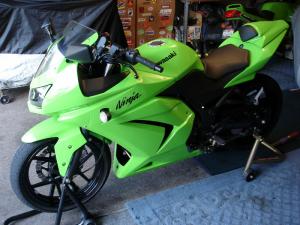
The only feedback I can share from today’s ride, is that the engine definitely responded favorably to the extra 3-4K RPM that was explored. You could tell that it was very happy to be called upon to begin flowing more air through the little cylinders. I have no doubt there’ll be more good stuff to come when the upper range of the engine’s speed is tested.
THE SUSPENSION:
Riding the previous generation Ninja 250 on stock suspension always demanded a lot of attention from the rider when upping the pace. Constantly trying to minimize the amount of work the suspension was being asked to do, by doing as much of the work as possible by the rider, was the key to not bottoming out, dragging hard parts on the pavement, and generally having a buckboard of a ride. Glad to be able to report that those days are gone on the ’08 Ninja 250!
The suspension is so firm and supportive that I found myself doing everything I could to consciously put the bike in a position where it would be doing as much of the work as possible. The more of the cornering forces, and pavement elevation change forces, that I directed right into the forks and shock, the more supple, and the more planted things felt. The key seemed to be getting enough weight on the suspension to put it down into the sweet-spot of its working travel. This was especially true of the front forks.
Personally, I love to ride a bike that has a front suspension that is firm enough that it demands you put a lot of weight forward on the bike while cornering; and yet will not penalize you by bottoming out as a result. The new Ninja 250’s forks behaved exactly in this manner on today’s ride. I sometimes refer to this behavior as a bike that likes to be ridden into the turns a bit like a “unicycle”, with a large percentage of the overall bike/rider weight over the front wheel. The bike did awesome when ridden this way today.
The #3 position that the rear shock preload is set at on my bike, confirmed itself on today’s more spirited ride to definitely be the best setting for my 170lb. rider weight. Turns in nice, holds a line, and is still rock stable. Can’t beat that! One take-away from the feedback of the bike’s suspension, as a result of riding the bike at the two different levels over the last two days, was that this bike will reward riders that have the skill (and desire) to work the bike hard ….. and will be less user-friendly (then the previous generation Ninja 250) on anything but smooth roads, for less experienced and/or aggressive riders.
HANDLING:
I was absolutely blown away by the stability and precision that the bike showed today at the more spirited pace! The bike truly behaves as one entity, with zero front/rear “disconnect” (side-to-side movement) that is often seen on other bikes. 
Racing one of these new ’08 Ninja 250’s will be a total hoot, as making totally clean passes in tight quarters, where it hardly seems possible (at least if on a regular full-sized 400lb sportbik) will surely be on the menu. How a bike responds when the front brake is trailed into a turn is often a good measuring stick on the overall success achieved by the Engineers in designing the overall package. If that form of test was used to evaluate the new Ninja 250, it would pass with flying colors!
Unlike some bikes that tend to “stand up” when trailing the front brake deep into corners, this bike absolutely shines. The front end just feels even more planted, the more loading that the trail braking generates. Totally neutral, with the bike maintaining the exact line you’re asking for. There’s no question this little $3,500 bike could humble a lot of the high-dollar, big-bore sportbikes I’ve ridden, when it comes to late braking and slicing into a tight turn. David and Goliath ……. bring ’em on.
RIDER POSITION:
Due to the confidence that develops in the “firmness” and competence of the bike’s suspension, I found myself a lot less prone to shifting my body off the bike for cornering … compared riding done on the previous generation Ninja 250. Staying a lot more “on top of the bike”, and letting the bike (and suspension) work underneath me, seemed just right in most situations. I think this aspect will make the new bike a lot less physically demanding on a rider, when navigating the bike through twisty roads.
TRANSMISSION:
The precision and effortless shifting up or down between gears, continued to impress me. The shifting is so perfect that it’s almost like a semi-automatic transmission. One of the benefits proved to be the lack of demand on the rider’s attention that is spent on shifting this bike. The shifts occur right on cue, with so little effort, that the extra unused attention is available for focusing on more important things while carving up the corners.
BRAKES:
Delaying longer before slowing down for turns today, resulted in calling on the brakes to begin working harder. As a result, I began to truly appreciate the much-improved firmness and feel that’s transmitted through the front brake lever (compared to the previous generation bike). I didn’t experience any signs of brake fade, or lever travel increase, despite working the front brake without much rest (due to a lot of trail braking), when making the run through the turns on some steep downhill’s today. The pads and rotors appear to have begun to “bed-in” at this point, with the level of initial bite noticeably improved from yesterday’s first-ride.
WEIGHT/FEEL:
It’s really hard to believe that the ’08 Ninja 250 is a “heavier” bike (over the old model), when moving down the road at any speed. The bike felt almost like an extension of my own body …….. as if I was just flying along on a rail. Regardless of what a scale would say, when you’re riding this bike, it feels very light and narrow compared to likely anything ridden before ….. short of 125cc/250cc two-stroke GP bike.
TIRES:
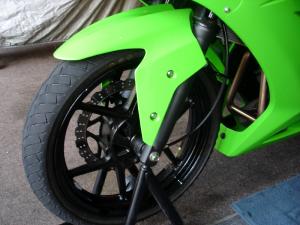
- It softened up a bit of the “harshness” that was being transferred into the bike’s chassis, on the rough/bumpy surfaces
- The tires seemed to have a higher level of “grip” with the pavement; on both rough or smooth pavement
I’m quite impressed with the Bridgestone BT-45 tires that came stock on the bike. Despite being pretty narrow, they haven’t slipped once unexpectedly, over what’s now been over 100 miles of backroad riding. Inspecting the tires at the end of today’s ride, showed that the rear tire had touched pavement to within a couple of millimeters of the edge, with the front being used a bit less ……with about 4mm’s of virgin rubber remaining.
GENERAL CHARACTERISTICS:
One of the biggest limitations and shortcomings of the previous generation Ninja 250, was “dragging hard parts” due to the combined effects of limited ground clearance (footpegs, centerstand, exhaust pipes, etc) and overall squishy suspension that would easily use up all of its travel. This aspect of the ’00 Ninja 250 that I’ve logged over 80K miles on, has been the most demanding on me as a rider when trying to enjoy riding the less-smooth backroads at a fun pace. Thankfully with the new ’08 Ninja 250 those days (and worries) are over!
The combination of the nicely tucked up single muffler, higher footpeg and lower control positioning, and a vastly improved level of support from the firmer suspension components, have done a great job in addressing this problem. I’m anxious to see what degree of lean angle the bike is going to be capable of achieving, before anything touches down (when ridden in the right environment, at the track).
CONCLUSION – RIDE #2:
The impressions after getting in a second day of brief test riding on the bike …… and doing so while pushing things a bit further? Was I still impressed? Hell yes!!! It was only getting better each time out. I figured that if things continued to get incrementally better at the same rate as they have so far over every 50 miles of riding on this new ’08 Ninja 250, I should reach total riding nirvana in about another 100 miles!
Ride #3 “Real World” Impressions (Looking for Nits)
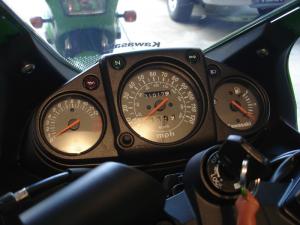
Recognizing that there’s nothing perfect in the real world, including motorcycles, I decided to dedicate yesterday’s ride to the process of looking beyond the sunshine and blue skies of taking ownership and riding a new bike ….. and focus all my attention on digging deep beneath the shiny new paint, and looking to identify the “nits” (e.g. shortcomings).
Being a budget-priced bike, there’s no question that some compromises needed to be made when Kawasaki was going to the parts bin to spec out individual components for the ’08 Ninja 250.
That’s the reality of life. You can only get so much, for so much money. Cartridge forks, fully adjustable shock, and complex computer controlled fuel injection systems just don’t come cheap. In keeping with the easy-to-digest itemized by category format of the earlier postings, for providing real world riding impression feedback, I’ll use that method for sharing the results of the “nits finding” mission from today’s ride. For those interested, please reference the following:
ENGINE: (Carburetion)
During the bulk of the 50+ miles that I put on the bike this evening, the riding was done while carving up some lightly traveled twisty backroads. Thanks to the open roads, the majority of those miles were spent at a moderately “spirited” pace, with the engine working mostly in the 7-10K range. In this mid-upper RPM range the fuel delivery, and resultant throttle response, had proven to be quite good. As a result, I had begun to come to the impression that all was rosy in the world of the carbureted USA model of the ’08 Ninja 250.
Normally getting stuck following traffic at a significantly sub-speed limit pace isn’t a good experience. However on the last few miles of yesterday’s ride, while on the last leg coming home, being subjected to this kind of riding environment proved to be a very valuable experience in the quest for uncovering the “nits” of the new bike. This “nit” appears in the form of a “hiccup” (momentary power lag, followed by a snatch as it kicks in again) when going from total off-throttle position, to just cracking the throttle back on again …… in approximately the 4,500 – 6,000 RPM range …… especially noticeable in the lower (3rd/4th, etc) gears.
While following closely being a train of cars in front of me (at around 30-35 MPH), every time they would go through their unexpected cycle of slowing and speeding up again, and I was forced to go to zero throttle and then come back into it again, I’d get a momentary “snatch” as if the bike lost fuel, and then had it turned back on again like a light switch. No matter how smooth I was on the throttle movement, as long as going all the way to zero throttle position was part of the off/on sequence (while in this RPM range), I’d get the “snatch”.
I experimented and found a work-around, which was to consciously keep just a small amount of throttle opening during those moments I was needing to slow for the traffic, and work the brakes slightly against the very light throttle to achieving the needed slowing. By keeping the carburetors off of their total zero idle circuits, and minimal butterfly/slide opening positions, it seemed to avoid this “bad spot”.
I suspect that the reason for this behavior can be traced back to the testing processes used by the government regulatory agencies for meeting the current strict level of emissions outputs that the bike had to meet for 2008. Likely the carburetors are setup extremely “lean” in that specific RPM range, as a necessity in meeting those standards. The penalty for meeting the emissions compliance materializing in the form of the stock bike exhibiting this “nit”; for new owners. Not a big deal, and likely can be addressed by creative carburetion tweaks …. but a “nit” none the less that should be noted in the effort of trying to provide an un-biased account of the bike for those potentially considering ownership.
SUSPENSION: (Damping Rates/Behavior)
Compression/Springs:
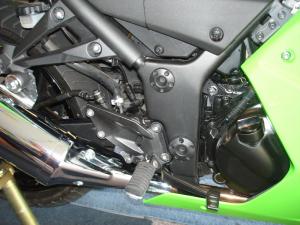
The behavior materializes in the form of having the tires prone to “skittering” (momentarily losing, and regaining, traction) over really rough pavement. The more conservatively the pilot is riding the bike, the more noticeable (and more of a “nit”) this behavior will be. This will be more of a factor for less experienced riders, where the previous generation Ninja 250 had a bit like a “comfy couch” feel (due to really squishy/soft suspension). The behavior associated with this aspect of the suspension on the ’08 model will be something they’ll see when riding on real world roads.
Rebound Damping:
This was an area where the previous generation Ninja 250 was SERIOUSLY lacking; at least the front forks. A “pogo-stick” was the best way to describe how the stock forks on the earlier bikes performed. It’s great to see that this historic, nearly non-existent rebound damping has been addressed by Kawasaki in the ’08 model. Unfortunately the budget price of the bike didn’t allow for the use of modern technology style suspenders. As result, the Engineers had to accomplish the additional damping using limited tools. The outcome is that the old-school “damping rod” style suspension is still WAY better then the old bike ….. but not without “nits”.
Statically testing the rebound damping in the garage, when I’d first got the bike, had already showed me that the amount (non-user adjustable) of damping (how slow it bounces back up) was slower then I would have preferred. The forks actually weren’t too far off, being pretty close to where I’d want them to be if I had an adjuster to turn. The rear shock was the primary culprit in this “too much damping” category. It should be noted that my bike has less then 200 miles on the odometer, so things are still in the process of “breaking in”. It’s possible that the shock’s rebound damping may loosen up a bit once it’s got more miles on it? We’ll just have to wait-n-see.
Recognizing this “too much rebound” characteristic of the suspension, and consciously keeping it in mind while out on the road test riding the bike, I anticipated areas on the road where I’d likely see the impact. The places where it ultimately surfaced in the most recognizable form, was when taking a few corners that were located at the crest of “uphill” rises. I found that the rear tire wanted to get a bit “light” (lose grip with the pavement) at those moments.
This was due to the unweighting effects of the pavement surface dropping away over the crest, and the rear shock not responding quickly enough to cause the swingarm to drop down at a rate where the rear tire would maintain maximum grip ….. in tracking with the road surface. It should be noted that it took riding the bike at what would be considered a VERY spirited pace (not top speed, but just cornering level for the tight/narrow backroads) in these spots, for a significant enough impact of the excessive rebound damping of the rear shock to become a fully recognizable event. Though the rebound damping is definitely not without flaw on either end of the bike (what you pay, is what you get typically, when it comes to suspension), I suspect that during the level of riding that most owners will do with the little Ninja 250, it won’t be greatly noticed while out on the road.
GENERAL – FUEL ECONOMY:
Prior to taking off on last night’s ride, I deliberately “topped off” the gas tank. The goal being to be able to get an initial feel for the fuel usage (MPG) of the ’08 model bike. The ride consisted of a mixture of approximately the following:
- 80% “Spirited” tight/twisty backroad riding (7-10K range)
- 20% city street in-traffic riding
In topping off the gas tank again (from a gas jug), upon arriving at home, the bike took right around 1 gallon to bring back to the pre-ride level. With the ride being about 55 miles today, it worked out easy to see the approximate average mileage (55 MPG) the bike had returned on this mixture of riding. As is so often said ….. “your mileage may vary”.
CONCLUSION – RIDE #3 – “Nit Hunting”
The limited number of items that surfaced, despite this being a very deliberate “nit hunting” mission, shone well on the ’08 Ninja 250. A pretty small list; from a $3,500 motorcycle! Hopefully digging out these “nits” from the recent real world riding experiences with this new bike, and sharing them in this Real World review, will be of some value for other potential owners (or eventual owners).
Ride #4 “Real World” Impressions (Full Anger Mode – & a Miracle)
The new bike was showing about 160 miles on the odometer at the start of the first weekend of riding, as a result of the three 50’ish mile first impression mini test rides that I’d managed to squeeze in during the previous evenings after work.
Fresh oil had been put into the engine at that early mileage mark in an effort to ensure any initial break-in impurities were removed. At this more established stage of ownership, this posting will cover the impressions taken away from a solid 350 miles of “spirited” riding that was done on the local twisty backroads, while enjoying two days of beautiful California winter weather (sunshine, dry roads, and temps nudging into the 70’s).
In keeping with the itemized format previously used for evaluation of the various categories of the new bike; this weekend’s impressions/experiences are again presented in that fashion.
ENGINE:

The engine runs great through the RPM range, and definitely does a good job of pulling the rider along nicely during general riding, while just cruising her along in the 6-8K range, but that upper RPM “hit” (10K-13K) of the previous generation bike just seems to be slightly soft on the ’08 model. Riding this weekend with the many of the same experienced riders (on their 600-1000cc machines) that I’ve spent time with in the hills in the recent past, while mounted on the old bike, I was able to somewhat gauge where the ’08 bike’s actual performance stacked up. Measuring how hard I had to work the little bike, to blend in with the riding of the folks on their bigger-bore machines, provided some pretty quantitative feedback. The key for optimizing the strengths of the new bike, during this “spirited riding”, was in recognizing that banging downshifts every time the engine dropped below the 11K range is not necessary, or in its best interest.
Letting the upper-midrange (8K-10K) pull the bike along, results in getting down the road in a very efficient manner, at a lot better pace then the lack of screaming engine RPM (of the old bike) might imply. For those looking for the root of the missing top end “hit” of the old bike, I’m not sure where that lies. It may be in the modified cam profile and timing, the new catalytic converter equipped exhaust, emissions-friendly carburetor jetting ….. or some combination? The bottom line however on engine performance, based on 500+ miles of real world riding experience on the new bike, is that this lack of extreme top-RPM “hit” doesn’t make the bike any slower then the old generation machine.
If anything, the added “grunt” of the upper-mid, if utilized smartly by the rider, can result in the ’08 bike running a stronger pace then the old bike. This is true; at least on anything short of taking the bike out on track in a roadracing environment.
CHASSIS/SUSPENSION:
The significantly increased “firmness” of the suspension on both ends of the ’08 bike (compared to the pogo-stick ’88-’07 machines) has already been well noted in the earlier segments of the bike review. On the second day of the weekend riding I had a chance to really put the suspension to a worst-case test out on an incredibly tight/twisty, bumpy, up-n-down rollercoaster style of backroad (“Stage Road”.) in the local Northern California mountains. 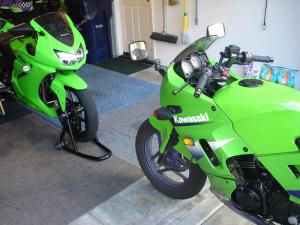
At a “spirited” pace, this has occurred to the point where the exhaust pipe, shift lever, rear brake lever, side and center stand all touched down to pavement at various times ….. providing a shower of sparks …. and badly upsetting the bike. Not a fun moment!
Recognizing this limitation on the old bike, required a lot of effort on the part of the rider to try to minimize the impact. Keeping the bike as vertical as possible, being on the throttle just prior to (and during) the “G-Out” (to keep the engine working the drive chain through the rear wheel to provide some “anti-squat” assistance), and using a lot of leg-suspension by the rider, were all required. Carving up those very same turns on Sunday, on the ’08 bike, totally changed everything!
The bike has what so far appears to be almost unlimited ground clearance between “hard parts” and the pavement (at least as setup on preload #3 position, and my 170 lb. rider weight).
The combination of the high clearance, and “firm” suspension, resulted in not a single “G-Out” moment ….. despite the pace being (if anything) a bit more “spirited” then most past rides on the old bike. It definitely takes a ton of the stress out of riding the bike briskly on lesser quality roads, where there’s higher demands put on the suspension. Good stuff!
P.S. As hard as it was for me to believe (from what I found over the last 500 miles of riding), experienced riders that take one of these little bikes out in an environment (the track) where “getting a knee down” is commonplace …… are going to find it’s REALLY HARD to touch a puck on this new bike!
The combination of the “firm” suspension (that doesn’t squat under load going into the turns) the taller seat height (and wider), and the higher rearset/footpeg position, keep the ground a long ways away while cornering. This is true even when leaning the bike quite far over (to within a few mm’s of the edge of the OEM rear tire). This capability being a total 180 degree opposite of the “old” (last generation”) bike!
FUEL MILEAGE:
There were some intervals (miles) of riding this weekend where the bike was exclusively being used on a series of very tight/twisty, mostly un-traveled backroads, at a consistently “spirited” pace. Due to the lower speeds of the twisty roads, the bike was being worked a lot in the lower gears, and at higher RPM.
Based on past experience, this form of riding always puts the highest demands on fuel economy. After completing about a 115 mile loop which consisted mostly of this form of riding, a gas fill-up was done to check how thirsty the bike had been in this most demanding form of use. The bike took about 2.5 gallons to fill back up.
This figured out to an average mileage, for that extreme level of riding, of: * 46 MPG (lowest) Pretty amazing mileage (compared to a 600cc+ machine), considering the type of riding!
OVERALL IMPRESSIONS:
A good friend, and weekend riding partner of mine (that happens to also be a very fast local roadracer with about 20 years of experience) joined me on Sunday’s ride. He’s ridden with me many times over the last few years, on his CBR-600 and CBR-1000 Hondas, while I was on the old Ninja 250.
Despite riding with me on the little bike (prior to yesterday) he’s never thrown a leg over a Ninja 250, much less ridden one. After our breakfast stop up at “Alices” restaurant (an infamous sportbikers watering hole at the top of the mountain roads in our area) I offered him a chance to swap bikes for a short test ride during the first stint of our day’s riding.
The good looks of the ’08 Ninja 250 (over the previous generation model) was the carrot that pushed him over his previously shown total lack of interest in riding one of these little 250cc machines. We headed out on an 8 mile stretch of Hwy 35, heading north, to the junction point of our proposed turnoff onto one of the tastier little goat trail roads in our local sportbike riding area (“Tunitas Creek Rd”).
I waved my friend by at the start, to allow him a chance to set the pace to whatever he felt comfortable with ……. as well as to allow me a chance to actually see what the little green bike looked like in action. The first of the twistys started less then a mile up the road, and I was amazed to see that within about 3 turns, his body posture changed dramatically. He went from a “I’m just sitting here cruising along checking out someone else’s bike” ….. to a “lets carve ’em up” mode.
I was grinning ear-to-ear in my helmet as began to see a gap developing between us, as he exited a couple of consecutive tight turns, while dropping into the “spirited” mode. I found myself actually having to get into the throttle a bit on his 600RR, to use the superior power to close things back up again. Wow …….. I couldn’t believe it. He’s REALLY having a blast riding that thing!
This cat-n-mouse continued for the next five miles, with him looking more and more confident, and having more and more fun, as every turn fell behind us. Pulling into parking area at stopping point for our turnoff to the goat trail road, I got off his Honda and walked over to him. He was still sitting in the saddle of the Ninja, and didn’t seem in any hurry to get off. His last comment to me, as we debriefed a bit on the test ride, was “let’s go!. This was accompanied by a head gesture motioning in the direction of the entrance to the road we were about to ride. Apparently he was all set to stay on the little 250, and continue with the fun. Being a bit of a party-pooper (but doing so with a smile) and proud papa, I replied; “If you want to ride one of these little Ninja 250s any more at this point …… you’re just gonna have to buy one of your own”. At that point we swapped bikes back, and headed out for what ended up being another 100 miles of great riding by the end of the day.
The significance of the reaction of my friend, from his brief test riding experience on this new ’08 Ninja 250, cannot be understated. The fact that this particular individual came away with a big smile on his face, really had a blast riding the bike, and commented verbatim after his ride; “One of these bikes would really be a lot of fun for riding on the roads up here!” speaks volumes for the success and recognition that Kawasaki engineers and designers deserve for their work in creating this new generation bike. It only gets better with every ride ……….. can’t wait for each new opportunity! Congratulations Kawasaki …….. “you done good”. I hope you guys sell the _hit out these little bikes. It’d be great to see a lot more riders that are better suited to smaller displacement machines ….. get off the bigger-bore bikes ……… and onto something where they can have a great time, and really learn the art of riding. Happy riding all! Gary S. Jaehne Scotts Valley, California


